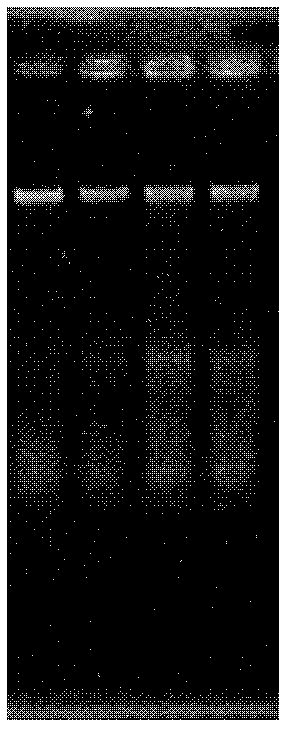Corn fungus inducing promoter and activity analysis
An inducible and promoter technology, applied in the field of bioengineering, can solve the problem of less inducible promoters, and achieve the effect of solving the problem of food crisis
- Summary
- Abstract
- Description
- Claims
- Application Information
AI Technical Summary
Problems solved by technology
Method used
Image
Examples
Embodiment 1
[0034] Example 1: Cloning of the fungal-inducible promoter of maize endochitinase A gene ZmECA
[0035] The promoter of maize endochitinase A gene ZmECA (the promoter sequence comprises the DNA nucleotide sequence of the -1bp to -1729bp region relative to the transcription initiation site of SEQ ID NO: 1), at the 5' non-translation of the maize ZmECA gene identified in the region sequence.
[0036] The maize endochitinase A gene ZmECA is registered in NCBI GenBank (accession number: NM_001165432.1), and the sequence listing shows the DNA sequence of the plant fungal-inducible promoter and 5' untranslated region of the above-mentioned gene of the present invention. In the list of promoter sequences in this document, base C of the transcription initiation site is indicated with +1. And use the promoter analysis website to analyze the core elements of the promoter.
[0037] Promoter analysis website http: / / bioinformatics.psb.ugent.be / webtools / plantcare / html / .
[0038] Maize geno...
Embodiment 2
[0042] Embodiment 2: Construction of plant fungus inducible vector
[0043] The fungus-inducible promoter of the maize endochitinase A gene ZmECA cloned in Example 1 and the 5' untranslated region ZmECAPro of 99 bp (see sequence listing) were inserted into the vector, thereby constructing the plant fungus-inducible vector.
[0044] More specifically, the plant expression vector pCAMBIA1301 and the recombinant plasmid pMD18-T::ZmECAPro were respectively digested with HindIII and NcoI, and then inserted into the HindIII and NcoI restriction sites of the vector pCAMBIA1301. This vector is called pCAMBIA 1301::ZmECAPro, used to drive the expression of GUS gene, identified by PCR ( Figure 4 ) and enzyme digestion identification ( Figure 5 ) to obtain the recombinant plasmid of the promoter and the vector.
[0045] exist Figure 7 Among them, the gene GUS encoding β-glucuronidase is used as the reporter gene, and the selection marker is the hygromycin resistance gene. In additi...
Embodiment 3
[0046] Example 3: Identification of the activity of the corn fungus-inducible promoter of the present invention
[0047] By electric transformation method, the carrier pCAMBIA1301::ZmECAPro constructed in embodiment 2 is transferred in Agrobacterium tumefaciens EHA105, extracts plasmid and carries out PCR identification ( Figure 6 ).
[0048] In order to identify the fungal inducible activity of the promoter, the corn embryo was treated with salicylic acid by the method of Jefferson et al. (EMBO J, 1987), and then the activity of GUS was detected.
[0049] More specifically, the corn seeds are soaked to accelerate germination, then the seeds are cut in half longitudinally, induced by salicylic acid for 24 hours, and the corn seeds are placed in the GUS test solution at 37°C overnight, GUS test solution: 3mg / ml X- gluc (5-bromo-4-chloro-3-indole-β-D-glucuronide), 50mM sodium phosphate buffer solution (PH=7.0), 10mM EDTA, 0.5mM potassium ferricyanide, 0.5mM ferrocyanide Potas...
PUM
 Login to View More
Login to View More Abstract
Description
Claims
Application Information
 Login to View More
Login to View More - R&D
- Intellectual Property
- Life Sciences
- Materials
- Tech Scout
- Unparalleled Data Quality
- Higher Quality Content
- 60% Fewer Hallucinations
Browse by: Latest US Patents, China's latest patents, Technical Efficacy Thesaurus, Application Domain, Technology Topic, Popular Technical Reports.
© 2025 PatSnap. All rights reserved.Legal|Privacy policy|Modern Slavery Act Transparency Statement|Sitemap|About US| Contact US: help@patsnap.com



